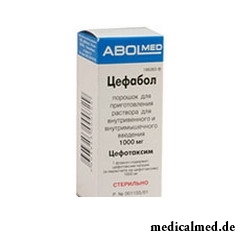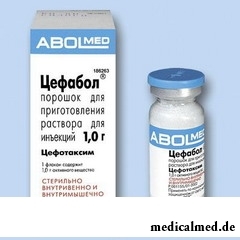





Tsefabol
Application instruction:
Tsefabol – the antibacterial  medicine (cephalosporin of the third generation) applied at treatment of a wide range of infectious diseases.
medicine (cephalosporin of the third generation) applied at treatment of a wide range of infectious diseases.
Pharmacological action of Tsefabol
Active component of Tsefabol – tsefotaksy, being a tsefalosporinovy antibiotic of the third generation, possesses a wide range of antimicrobic action.
Tsefabol shows activity concerning gram-positive and gram-negative microorganisms which are usually steady against other antibiotics.
Release form
Tsefabol release in the form of powder for preparation of solution for injections. Rolled into one (10 ml) active component – tsefotaksy in number of 500 mg or 1 g contains.
Tsefabol's analogs
Drugs belong to Tsefabol's analogs on active agent: Intrataksim, Klafobrin, Oritaks, Rezibelakta, Taltsef and Tsefotaksim.
The main analogs of Tsefabol on a way of action are the following medicines: Azawounds, Betasporina, Steritsef, Dardum, Vitsef, Ifitsef, Axon, Lorakson, Lorazidim Movigip, Pantsef, Rotsefin, Orzid, Supraks, Torotsef, Sulmover, Tizim and others.
Indications to Tsefabol's use
According to the instruction Tsefabol appoint for treatment of bacterial infections of a heavy current which are caused by microorganisms, sensitive to effect of the medicine. Treatment by drug effectively at infections:
• ENT organs and airways, including pneumonia;
• The central nervous system, including meningitis;
• Urinary tract, including acute pyelonephritis and during the periods of an aggravation of chronic disease;
• Joints and bones;
• Skin and soft tissues, including the wound complications caused by operations;
• An abdominal cavity (uncomplicated and complicated), including such diseases as peritonitis, a cholangitis and cholecystitis, and also postoperative abscesses of an abdominal cavity;
• Bodies of a small pelvis, including an endometritis, a pelviperitonitis and an acute current of an adnexitis, and also at an aggravation of chronic disease;
• Urinogenital system, including gonorrhea and clamidiosis;
• Against the background of an immunodeficiency.
Also Tsefabol appoint for treatment of such diseases as:
• Lime disease (borreliosis);
• Endocarditis;
• Sepsis;
• Salmonellosis.
Besides, Tsefabol is effective for prevention of infections after many surgeries:
• Carried out on digestive tract;
• Obstetric and gynecologic;
• Urological.
Tsefabol's contraindications
Tsefabol according to the instruction it is contraindicated to apply at hypersensitivity to active or to auxiliary components which are a part of medicine, and also at intolerance of penicillin, other cephalosporins and karbapenem.
Tsefabol, as a rule, appoint with care in the following cases:
• In the period of a lactation;
• At a chronic renal failure;
• In the period of a neonatality;
• At nonspecific ulcer colitis.
The possibility of use Tsefabola at pregnancy has to be solved individually the doctor taking into account possible advantage and risk for mother and the child.
Tsefabol route of administration
Tsefabol according to the instruction apply intramusculary and intravenously (struyno or kapelno). The dosage of medicine depends on age and a disease.
At uncomplicated infections and at infections of urinary tract to adults and children at whom body weight is higher than 50 kg appoint 1 g of Tsefabol each 8-12 hours.
At moderately severe infections the dosage makes 1-2 g twice a day with an equal interval (each 12 hours).
At meningitis or other heavy infections the dose is increased to 2 g by each 4-8 hours, but it is no more than 12 g in day.
At uncomplicated acute gonorrhea Tsefabol apply once 1 g.
The newborn (up to 1 week), and also to premature children the dosage is calculated proceeding from weight – on 50 mg/kg applied each 12 hours. To children from one to four weeks the same dose is entered by each 8 hours.
The daily dose for children of more advanced age with body weight to 50 kg makes 50-180 mg/kg divided into 4-6 dosages.
Before carrying out operations for prevention of development of infections, as a rule, enter once 1 g of Tsefabol, and if necessary the same dose can be entered in 6-12 hours.
In cases of performing Cesarean section when imposing clips on an umbilical vein enter also 1 g of medicine, and then administer repeatedly the same amount of the drug in six and twelve hours.
Cesarean section when imposing clips on an umbilical vein enter also 1 g of medicine, and then administer repeatedly the same amount of the drug in six and twelve hours.
In cases of overdose by Tsefabol such symptoms as spasms, a tremor, encephalopathy and the increased neuromuscular excitability can be shown.
Medicinal interaction
At Tsefabol's use it is necessary to consider that at co-administration with non-steroidal anti-inflammatory drugs and antiagregant the risk of development of bleedings increases.
The probability of damage of kidneys sharply increases at joint reception of Tsefabol with polymyxin B, aminoglycosides and "loopback" diuretics.
Tsefabol pharmaceutical is incompatible in one syringe or a dropper with solutions of other antibiotic drugs.
Side effects
Tsefabol according to reviews can cause various allergic reactions most of which often are shown in a look:
• Fever or fever;
• Small tortoiseshells;
• Itch;
• Rashes;
• Eosinophilias;
• Bronchospasm;
• Acute anaphylaxis;
• A malignant exudative erythema (differently – Stephens-Johnson's syndrome);
• Quincke's disease;
• A toxic epidermal necrolysis (differently – a Lyell's disease).
Besides, Tsefabol's use according to reviews can lead to disturbances from various systems of an organism and cause:
• Meteorism, stomatitis, vomiting, abnormal liver function, glossitis, nausea, pseudomembranous coloenteritis, dysbacteriosis, diarrhea or lock, abdominal pain (alimentary system);
• An anury, an azotemia, intersticial nephrite, an oliguria, increase in content of urea in blood (urinary system);
• Hemolitic anemia, neutropenia, leukopenia, hypocoagulation, thrombocytopenia, granulocytopenia (bodies of a hemopoiesis);
• Potentially life-threatening arrhythmias arising after bolyusny bystry introduction to the central vein (cardiovascular system);
• Dizziness and headache (nervous system).
Also Tsefabol's use according to reviews sometimes causes local reactions after introduction of medicine, and in certain cases can lead to development of superinfection, for example, to a mycotic vulvovaginitis.
When performing treatment by Tsefabol, especially for the first 10-12 days, sometimes there is pseudomembranous colitis which is usually shown as heavy long diarrhea. In this case Tsefabol's use should be stopped and carried out adequate therapy which includes metronidazole or Vancomycinum.
Storage conditions
Tsefabol treats a number of tsefalosporinovy antibiotics which issue from drugstores is possible according to the recipe of the doctor. A medicine period of storage at observance of the recommended conditions – two years.
People who got used to have breakfast regularly have obesity much less often.

The majority of gynecologic diseases prove three main signs, each of which speaks about need to the visa...
Section: Articles about health
The business lady, the become mother, it is necessary to solve an array of problems. But of them is main: how to combine the beloved child and work? What traps trap the working mother and how she needs to behave?...
Section: Slideshow
Antibiotics - - it is possible to call the chemical compounds suppressing growth of bacteria the break in the field of medicine which allowed to save mankind from many diseases incurable earlier: tuberculosis, plague, syphilis and many others. The contribution of drugs to rescue of people from epidemics of dangerous infections is huge, however at careless use antibiotics are capable to cause to an organism serious damage. Negative action can be shown in the form of easing of immunity, disturbance of balance of microflora in кишеч...
Section: Articles about health
It is possible to find the extensive range of fruit and vegetables in modern shops. Russians already got used that on counters in any...
Section: Articles about health
The varicosity has familiarly many, statistically, this disease more than a half of all adult population. As a rule, the varicosis affects preferential superficial vessels, and is shown by characteristic cosmetic defects. Guo...
Section: Articles about health
Nightmares belong to the most unpleasant frustration. Statistically, they happen at 4% of adults, and almost at 70% of children and teenagers. During a nightmare of people dreams himself in extremely difficult, life-threatening situation. He wakens suddenly, in a condition of a fright, and, as a rule, remembers the dream distinctly. The feeling of depression and alarm does not release throughout the day, creating hindrances for work and normal communication. If such episodes repeat often, can р...
Section: Articles about health
Heart disease and blood vessels lead to disturbance of blood supply of bodies and fabrics that involves failures in their works...
Section: Articles about health
Practice of hypnotic impact on consciousness of the person contains about two millennia. During this time scientists managed to learn a lot of things about a phenomenon of hypnosis and learned to facilitate a condition of the patients having heavy illnesses with its help....
Section: Articles about health
The thought that the mass of their body is too big at least once in life visits from 80 to 95% of women. Many women are so obsessed with this idea that constantly try all new and new ways of weight reduction. A considerable part of these techniques is ineffective, and some in general are unsafe for health....
Section: Articles about health
The endocrine system carries out in a human body extremely important role, practically all processes of life activity регулируютс...
Section: Articles about health
History of mankind contains several tens of epidemics whose emergence was compared by eyewitnesses and historians to doomsday. The most terrible of them claimed the lives of millions of people, having made even the whole people to the person of the earth. What they − the diseases striking terror? Daringly...
Section: Articles about health
All of us, unfortunately, should face flu nearly an every year. It would seem, so frequent disease has to be studied already up and down, and each person, at least once to them had (and the number of such people in our country aims at 100%), has to know the basic rules of its treatment. However as shows experience of doctors, there is no it, and often people, self-confidently thinking what is known as it is necessary to be treated, make mistakes....
Section: Articles about health
Any of us is not insured from a heavy illness of the loved one. Happens and so that someone from family members becomes lying бо...
Section: Articles about health
Maternal milk is the best food for the newborn. It is the unique natural product containing an optimum set of nutrients, and which is best adapted in order that the baby normally developed and it was protected from harmful fa...
Section: Articles about health
Is told about advantage of domestic animals for development of the child much. But many parents nevertheless do not hurry to bring pets as are afraid that they can do harm to health of children. What troubles can really trap kids and how to make joint life of a family and domestic animals comfortable and safe?...
Section: Articles about health
Household skills which to us so diligently imparted in the childhood it appears, not always bring only benefit. According to result...
Section: Articles about health
Each person supports all life a SARS about 200 times. The peak of incidence falls on cold season, but it is possible to get sick with a temperature and a pharyngalgia, and sometimes and very possibly, even during a heat. The reasons for development of catarrhal diseases exists множество:...
Section: Articles about health
Eyes – unique body on the structure thanks to which the person obtains about 80% of information on the world around: about a form, color, size, the movement, and also many other parameters of objects or phenomena. But whether much we know about the most valuable sense body which, according to the scientist Sechenov, provides us about one thousand various feelings a minute? Let's consider 10 most surprising facts about eyes and sight....
Section: Articles about health
Cellulitis - very widespread cosmetic shortcoming which arises approximately at 80% of women sooner or later. Emergence ег...
Section: Articles about health
Smack in a mouth can arise in the natural way – as a result of lack of morning hygiene or reception of the corresponding food. However in certain cases its existence is a sign of certain pathologies, and allows to reveal an illness at an early stage. In we depend...
Section: Articles about health
Good appetite was always considered as a sign of good health. The correct operation of the mechanism which is responsible for the need for nutrients and receiving pleasure from process of its satisfaction demonstrates that the organism functions without special deviations. On the other hand, appetite of the person is not a constant. It depends on the culture of food, flavoring addictions imparted since the childhood which can change during life, weather, mood and many д more than once...
Section: Articles about health
Tea is loved and use almost everything. This drink has tonic properties, contains the tannins capable podavlit...
Section: Articles about health
The brain of the person is studied not one hundred years, but the quantity of the riddles connected with this body increases rather, than decreases. Perhaps, numerous delusions concerning a structure and functioning of a brain, many are explained by it from...
Section: Articles about health
More than a half of the married couples which faced prostatitis – leave. The new broadcast "Female View of Prostatitis" will help to learn – whether you have or your relatives problems....
Section: Articles about health
The mankind knows that some toxins at intake in the minimum quantities have therapeutic effect...
Section: Articles about health
With age in a human body harmful substances collect. We receive them with food and water, at inhalation of the contaminated air, reception of medicines, use of household chemicals and cosmetics. A considerable part of toxins accumulates in a liver, osnovno...
Section: Articles about health
Aging — natural and inevitable process. Over time our skin loses elasticity, on it saggings are formed, the face form loses former clearness. The procedure of nitevy lifting (nitevy tightening) can successfully solve this problem. In order that it is better to get acquainted with this popular procedure, we will tell you 6 cognitive facts about it....
Section: Articles about health
